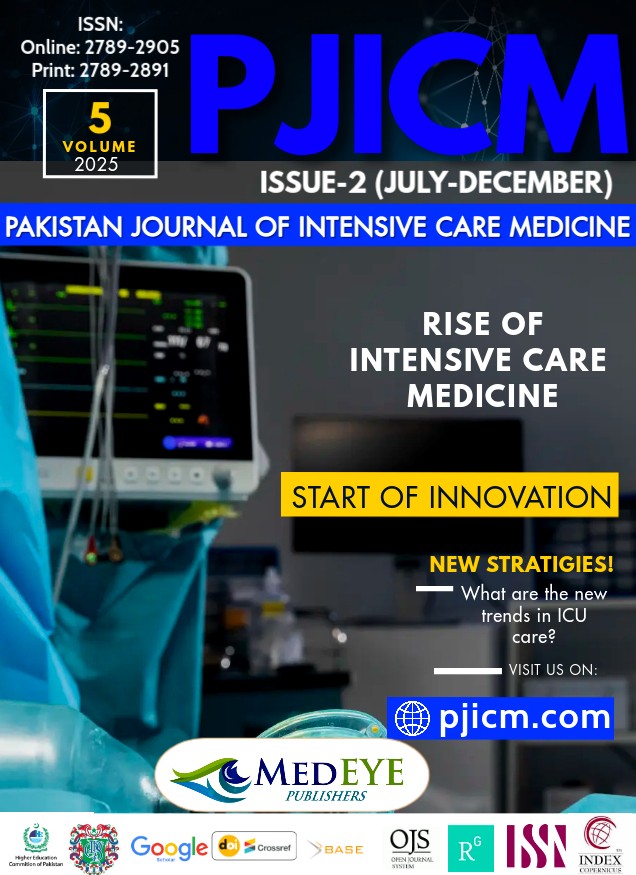COMPARISON OF PERIOSTEAL ELEVATOR WITH AND WITHOUT DEXAMETHASONE INJECTION FOR THE PREVENTION OF LINGUAL NERVE INJURY IN AN OPEN EXTRACTION OF MANDIBULAR THIRD MOLARS
DOI:
https://doi.org/10.54112/pjicm.v5i02.185Keywords:
Lingual Nerve Injury, Dexamethasone, Periosteal Elevator, Third Molar Extraction, Neurosensory Testing, Randomized Controlled Trial.Abstract
Background: Lingual nerve injury (LNI) is a recognized complication during mandibular third molar surgery, often resulting from excessive traction or manipulation of the lingual flap. The use of periosteal elevators for lingual retraction is a common practice, while corticosteroids such as dexamethasone have been suggested to minimize postoperative inflammation and nerve injury. Objective: To assess the incidence of lingual nerve injury by comparing two surgical approaches—lingual retraction using a periosteal elevator alone versus retraction with a periosteal elevator preceded by preoperative steroid therapy. Study Design: Randomized controlled trial. Setting: Department of Oral and Maxillofacial Surgery, at Sardar Begum Dental College and Hospital, Peshawar, Pakistan. Duration of Study: From 23 February 2025 to 23 May 2025. Methods: A total of 88 patients requiring mandibular third molar extraction were randomly allocated into two groups (n=44 each). Group A underwent lingual flap retraction using only a periosteal elevator. At the same time, Group B received a single intramuscular dose of dexamethasone (4 mg) one hour preoperatively, followed by lingual retraction using a periosteal elevator. Postoperative lingual nerve sensory function was evaluated on the 7th postoperative day using standardized neurosensory tests. Data were analyzed using SPSS version 23, and the chi-square test was used to assess intergroup differences; p < 0.05 was considered significant. Results: The mean age of patients was 35.14 ± 11.08 years in Group A and 41.20 ± 11.89 years in Group B. The incidence of lingual nerve injury was 6.8% in Group A and 2.3% in Group B. The difference between the two groups was not statistically significant (p > 0.05). Conclusion: Preoperative administration of dexamethasone before lingual retraction slightly reduced the incidence of lingual nerve injury following mandibular third molar extraction; however, the difference was not statistically significant. Further studies with larger sample sizes and long-term follow-up are warranted to confirm these findings.
References
Jafarian M, Etebarian A. Reasons for extraction of permanent teeth in general dental practices in Tehran, Iran. Med Princ Pract. 2013;22(3):239–44. https://doi.org/10.1159/000345979
Alesia K, Khalil HS. Reasons for and patterns relating to the extraction of permanent teeth in a subset of the Saudi population. Clin Cosmet Investig Dent. 2013;5:51–6. https://doi.org/10.2147/CCIDE.S49403
Jung YH, Cho BH. Radiographic evaluation of third molar development in 6- to 24-year-olds. Imaging Sci Dent. 2014;44(3):185–91. https://doi.org/10.5624/isd.2014.44.3.185
Tuteja M, Bahirwani S, Balaji P. An evaluation of third molar eruption for assessment of chronologic age: a panoramic study. J Forensic Dent Sci. 2012;4(1):13–8. https://doi.org/10.4103/0975-1475.99154
Hashemipour MA, Tahmasbi-Arashlow M, Fahimi-Hanzaei F. Incidence of impacted mandibular and maxillary third molars: a radiographic study in a Southeast Iran population. Med Oral Patol Oral Cir Bucal. 2013;18(1):e140–5. https://doi.org/10.4317/medoral.18028
Rödel R, Lang J. [Peripheral branches of the facial nerve in the cheek and chin area. Anatomy and clinical consequences]. HNO. 1996;44(10):572–6. German. https://doi.org/10.1007/s001060050056
Marcuzzo AV, Šuran-Brunelli AN, Dal Cin E, Rigo S, Piccinato A. Surgical anatomy of the marginal mandibular nerve: a systematic review and meta-analysis. Clin Anat. 2020;33(5):739–50. https://doi.org/10.1002/ca.23497
Gündoğdu Y, Asya O, Özcan S, Çavlan CE, Kersin B, Kucur C, et al. Surgical localization of the marginal mandibular nerve in relation to the inferior border of the mandible and the submandibular gland. B-ENT. 2024;20(4):226–31. https://doi.org/10.5152/B-ENT.2025.231478
Robinson K, Bhandari L, Anderson C, Konofaos P. Vascular and nerve relations of the marginal mandibular nerve of the face: anatomy and clinical relevance. Plast Reconstr Surg. 2020;145(2):460e–461e. https://doi.org/10.1097/PRS.0000000000006457
Kohan EJ, Wirth GA. Anatomy of the neck. Clin Plast Surg. 2014;41(1):1–6. https://doi.org/10.1016/j.cps.2013.10.001
Williams M, Tollervey D. Lower third molar surgery—consent and coronectomy. Br Dent J. 2016;220(6):287–8. https://doi.org/10.1038/sj.bdj.2016.189
Nehme W, Fares Y, Abou-Abbas L. Piezo-surgery technique and intramuscular dexamethasone injection to reduce postoperative pain after impacted mandibular third molar surgery: a randomized clinical trial. BMC Oral Health. 2021;21:—. https://doi.org/10.1186/s12903-021-01759-x
Wanithanont P, Chaiyasamut T, Vongsavan K, Bhattarai BP, Pairuchvej V, Kiattavorncharoen S, et al. Comparative efficiency of the preoperative pterygomandibular space injection of two doses of dexamethasone in mandibular third molar surgery. J Dent Anesth Pain Med. 2021;21(1):29–. https://doi.org/10.17245/jdapm.2021.21.1.29
Gupta A, Mohanty S, Sharma P, Chaudhary Z, Verma A, Hemavathy S. Is intra-masseteric dexamethasone better than intra-deltoid injection in reducing post-operative sequelae following impacted third molar surgery? A randomized clinical study. J Maxillofac Oral Surg. 2024;23(5):1226–33. https://doi.org/10.1007/s12663-024-02308-z
Stacchi C, Daugela P, Berton F, Lombardi T, Andriulionis T, Perinetti G, et al. A classification for assessing surgical difficulty in the extraction of mandibular impacted third molars: description and clinical validation. Quintessence Int. 2018;49(9):745–53. https://doi.org/10.3290/j.qi.a40778
Mushtaq M, Khan AH, Hussain A. The effect of dexamethasone on neuropraxia following third molar surgery. Pak Oral Dent J. 2011;31(1):48–50.
Bhuvana Chandra R, Selvarasu K, Menon VD, et al. Efficacy of dexamethasone in lingual nerve paresthesia following third molar surgery—a randomized controlled trial. J Popul Ther Clin Pharmacol. 2023;30(6):484–9.
Pogrel MA, Goldman KE. Lingual flap retraction for third molar removal. J Oral Maxillofac Surg. 2004;62(9):1125–30. https://doi.org/10.1016/j.joms.2004.04.013
Pichler JW, Beirne OR. Lingual flap retraction and prevention of lingual nerve damage associated with third molar surgery: a systematic review of the literature. Oral Surg Oral Med Oral Pathol Oral Radiol Endod. 2001;91(4):395–401. https://doi.org/10.1067/moe.2001.114154
Von Arx DP, Simpson MT. The effect of dexamethasone on neurapraxia following third molar surgery. Br J Oral Maxillofac Surg. 1989;27(6):477–80. https://doi.org/10.1016/S0266-4356(89)80005-1
Downloads
Published
How to Cite
Issue
Section
License
Copyright (c) 2025 A GUL , JA KUNDI , A AHMAD

This work is licensed under a Creative Commons Attribution-NonCommercial 4.0 International License.












